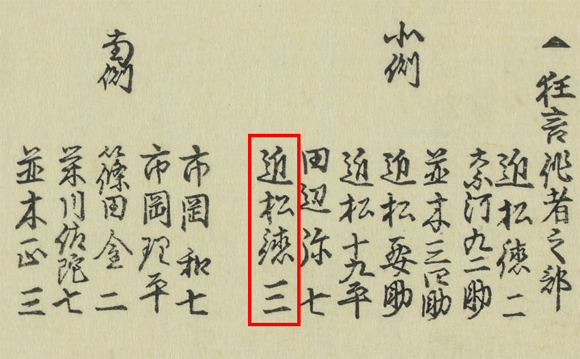| CHIKAMATSU TOKUZď |
|
Playwright names:
Other name: ďmasuya Tokuemon Guild: ďmasuya Poetry name: Gary˘ Existence: 1751 ~ 23rd day of the 8th lunar month of 1810 [1] Connection: Master: Chikamatsu Hanji Son: Kanazawa Issen Disciples: Chikamatsu Monky˘, Chikamatsu Y˘suke, Chikamatsu Tokuji, Chikamatsu Jisuke, Chikamatsu Kaz˘, Chikamatsu Manbŕ, Chikamatsu Tokubei, Sawaarashi T˘r˘ Career: 1751~1780s: born in Kamigata; fan of the ningy˘ j˘ruri puppet theater since his childhood, he became disciple of Chikamatsu Hanji and received the name Chikamatsu Tokuz˘ at unknown times. 4th day of the 2nd lunar month of 1783 [2]: his master Chikamatsu Hanji suddenly died in ďsaka while working on the drama "Igagoe D˘chű Sugoroku". 1784: he took the name of Chikamatsu Tokus˘. 11th lunar month of 1787: Tokus˘ became tatesakusha in ďsaka at the Naka no Shibai, where he wrote the kaomise drama "Masaru Medetaki Toshi no Kaomise", which was produced by Nakayama Fukuz˘; the main actors were Onoe Shinshichi I, Asao Tamejűr˘ I, Yoshizawa Iroha I, Kagaya Kashichi I, Nakamura Jiroza II, Yamamura Tomoemon I, Hanagiri Tomimatsu I, Nakamura Tomosabur˘, Nakamura Ky˘jűr˘ II, Arashi Bungor˘ I, Nakamura Kumenosuke and Onoe Tamiz˘ I. 7th lunar month of 1789: premiere at the Kado no Shibai of Namiki Gohei I and Tokus˘ drama "Kanjin Kanmon Tekuda no Hajimari" [more details]. 1st lunar month of 1793: premiere at the Naka no Shibai of the ni-no-kawari drama "Keisei Yanagi Zakura", the first yanagisawa-s˘d˘mono in Kabuki history, written by Tatsuoka Mansaku and Tokus˘ [more details]. 1st lunar month ~ 3rd lunar month of 1794: premiere of Tatsuoka Mansaku's drama "Keisei Haru no Tori", which was famous for its "Umagiri" scene and was produced by the zamoto Asao Okujir˘ I in ďsaka at the Kado no Shibai [more details]. Tokus˘ and Nagawa Shimesuke I work with Tatsuoka Mansaku on this drama. 11th lunar month of 1794: Tokus˘ worked in ďsaka at the Kado no Shibai, along with Tatsuoka Mansaku and Morita Monky˘, on the kaomise drama "Tatematsuru Chibako no Tamamono". 11th lunar month of 1795: he took the name of Chikamatsu Tokuz˘ and wrote, along with Tatsuoka Mansaku and Namiki Sh˘z˘ II, the kaomise drama "Ichiban Yari T˘kai Suzuri", which was produced by Fujikawa Hachiz˘ III (who celebrated his shűmei) at the Kado no Shibai; others main actors were Nakayama Bunshichi II, Sawamura Kunitar˘ I, Arashi Hinasuke II, Arashi Koroku III, Nakayama Bungor˘ I, Yoshizawa Iroha I, Mimasu Matsugor˘ I, Yamamura Giemon II, Yamamura Tomoemon I and Asao Sennosuke. 4th lunar month of 1796: premiere at the Kado no Shibai of the drama "Hade Kurabe Ishikawa-zome", written by Tokuz˘, Tatsuoka Mansaku and Namiki Sh˘z˘ II [more details]. 7th lunar month of 1796: premiere of Tokuz˘'s play "Ise Ondo Koi no Netaba" in ďsaka at the Kado no Shibai [casting]. 11th lunar month of 1797: Tokuz˘ wrote the kaomise drama "Mote Hayasu Manry˘ no Tachibana", which was produced by Nakayama Yosabur˘ II at the Kado no Shibai. 7th lunar month of 1798: premiere of Tokuz˘'s play "Sarumawashi Kadode no Hitofushi" in ďsaka at the Kado no Shibai [more details]. 11th lunar month of 1804: Tokuz˘ worked, along with Namiki Miyosuke and Nagawa Kunisuke [3], in Ky˘to at the Kitagawa no Shibai on the kaomise drama "Ichiy˘ ďgi no Kachidoki". 1st lunar month of 1805: Tokuz˘ worked in the same theater, with the same team of sakusha, on the new year ni-no-kawari drama "Keisei Miyako Yoshino" and the dance-drama "Matsu no Suma-goto". 11th lunar month of 1805: Tokuz˘ worked, along with Ichioka Washichi I and Nagawa Kunisuke [4], at the Kitagawa no Shibai on the kaomise drama "Shinshű Kawanakajima Kassen". 11th lunar month of 1809: Tokuz˘ wrote the kaomise drama "Keishoku Yuki-miru Yama", which was produced at the Kado no Shibai by Mimasu Kumesabur˘ and starred Nakayama Hyakka, Yoshizawa Ayame V, Arashi Kichisabur˘ II, Asao Kuzaemon I, Nakayama Shinkur˘ III, Nakamura Daikichi I, Kan˘ Minshi I and Asao Okuyama III. 1st lunar month of 1810: premiere at the Kado no Shibai of Tokuz˘ and Namiki Miyosuke ni-no-kawari drama "Keisei Sato no Funauta" [casting]. 23rd day of the 8th lunar month of 1810 [1]: Tokuz˘ died in ďsaka. Comments: Chikamatsu Tokuz˘ was an important Kamigata playwright, who fathered more than 80 dramas. He excelled in writing sewamono and oiemono dramas. When Namiki Gohei I left ďsaka to settle in Edo in Fall 1794, the two leading playwrights in Kamigata were Chikamatsu Tokuz˘ and Tatsuoka Mansaku. The former one excelled in writing sewamono while the latter one was the jidaimono expert. Around 1804~1806, Chikamatsu Tokuz˘ wrote a script, which was entitled "Asagao Nikki", the plot of which was suggested to him by a poem on the morning-glory and a folklore story. "After working in the puppet theater, Tokuz˘ eventually became a playwright for the Kabuki theater, where he pioneered innovative ways of bringing contemporary news and events to the stage, as well as modernizing old plays and adapting yomihon ("books for reading," a fiction genre flourishing in Kamigata,
featuring lengthy stories filled with romance and heroic figures, plus a dash of didacticism)" [1] The 23rd day of the 8th lunar month of the 7th year of the Bunka era was the 21st of September 1810 in the western calendar. [2] The 4th day of the 2nd lunar month of the 3rd year of the Tenmei era was the 6th of March 1783 in the western calendar. [3] The others sakusha were Tanabe Yashichi, Chikamatsu Y˘suke, Chikamatsu Tokuji and Chikamatsu Tokubei. [4] The others sakusha were Tanabe Yashichi, Ichioka Rihei |
 |
|
The name of Chikamatsu Tokuz˘ in a 1805 Ky˘to hy˘banki (the name within the red box) |
|
|
| Contact | Main | Top | Updates | Actors | Plays | Playwrights | Programs | Links | FAQ | Glossary | Chronology | Illustrations | Prints | Characters | Derivatives | Theaters | Coming soon | News |